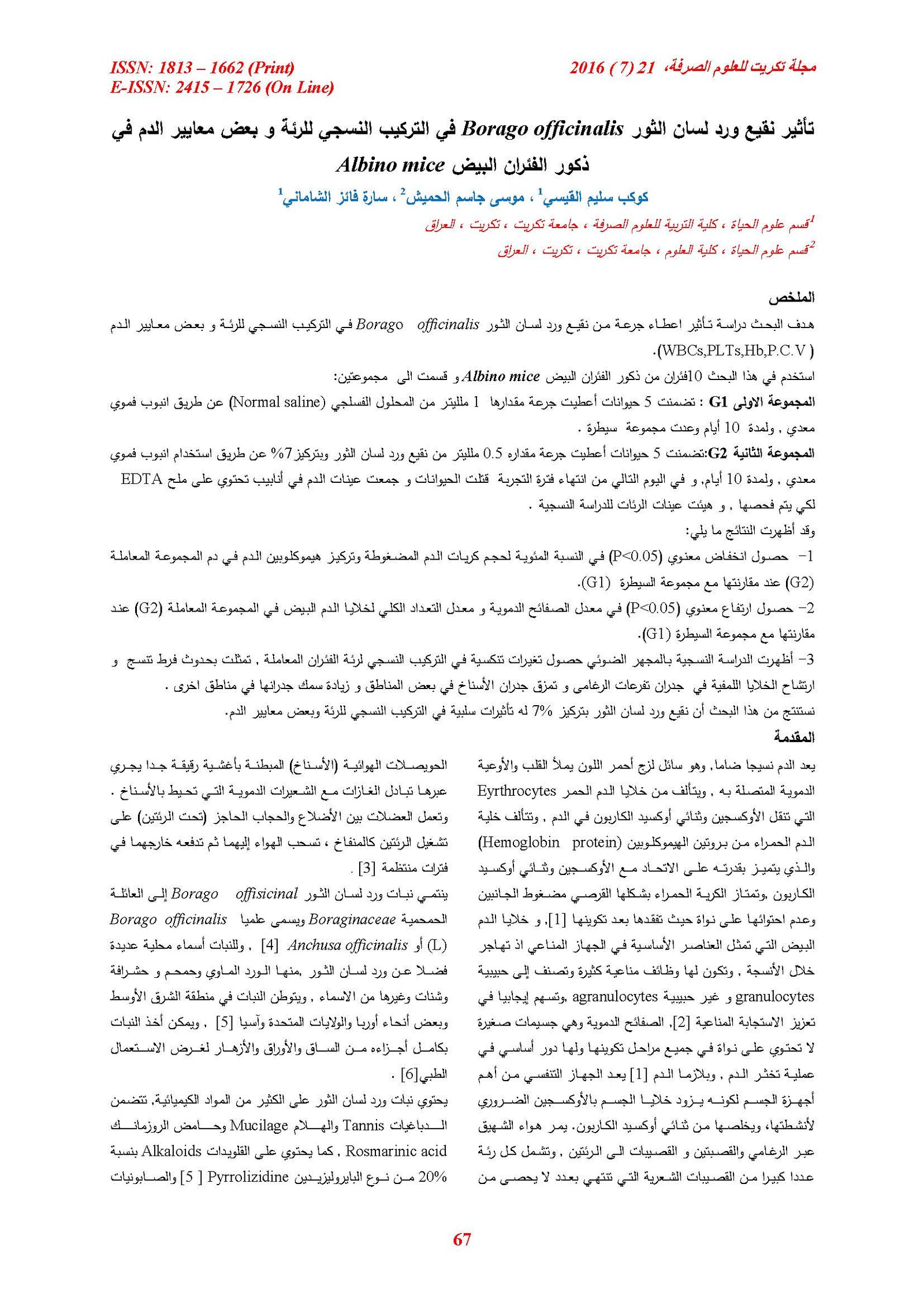The effect of Borag officinalis infusion in histological structure of lung and some blood parametars in white male mice
Main Article Content
Abstract
This study is designed to recognize the side effects of Borago officinalis infusion on the histological structure of lung and some blood parameters (WBCs, PLTs, Hb ,P.C.V ).
Ten Swiss white male mice were used, they were divided into two groups:
First group (G1): included five animals given a dose of 0.5ml of the physiological solution (Normal saline) by means of an oral-stomach pipe, for 10 days. It was considered to be the control group.
Second group (G2): included five animals given a dose of 0.5ml of Borago officinalis infusion by concentration %7 by means of an oral-stomach pipe for 10 days.
At the end of experiment all animals were killed and colleccted blood samples were collected gathered in tubes containing EDTA salt, and the Lungs were removed and preserved in formalin 10% .
The results showed the following:
- A significant decrease (P≤0.05) occurred in the rate of (P.C.V) bulk volume percentage of blood and Hb concentration of the second group(G2) when compared with the animals of the control group . And there was a significant decrease (P≤0.05) in the average of cellular heamoglobin MCHC of the (G2) compared with control group animals.
- There was a significant increase (P≤0.05) in the rate of blood platelets (PLT) and in the rate of the total amount of the white blood cells (WBC),in second group (G2 ) compared with the control group (G1).
- Histological examination showed occurrence of degenerative changes in the histological structure of the mice lung Hyperplasia and infiltration of lymphocytes in the walls of the trachea and rupture the walls of the alveoli in some areas and increase the thickness of the walls in other areas .
This study concluded that infusion Borago officinalis concentration 7% revealed a negative effected on the histological structure of lung and some blood parameters .
Article Details

This work is licensed under a Creative Commons Attribution 4.0 International License.
Tikrit Journal of Pure Science is licensed under the Creative Commons Attribution 4.0 International License, which allows users to copy, create extracts, abstracts, and new works from the article, alter and revise the article, and make commercial use of the article (including reuse and/or resale of the article by commercial entities), provided the user gives appropriate credit (with a link to the formal publication through the relevant DOI), provides a link to the license, indicates if changes were made, and the licensor is not represented as endorsing the use made of the work. The authors hold the copyright for their published work on the Tikrit J. Pure Sci. website, while Tikrit J. Pure Sci. is responsible for appreciate citation of their work, which is released under CC-BY-4.0, enabling the unrestricted use, distribution, and reproduction of an article in any medium, provided that the original work is properly cited.
References
1- Pack, P.E. (2001). Anatomy and physiology. Hungry Minds,3ed Avenue New York, Ny 10022. pp: 202-209.
2- Abbas, A. K.; Lichtman, A.H. and pober, J.S. (1991). Cellular and Molecular Immnnology. Saunders Philadelphia. pp: 97-101 .
3- Rogers, E. S. (2011). The Respiratory system. By Britannica Educational Publishing, in association with Rosen Educational Services, New York, pp:19-30.
4- Anwarul, H.G.; Samra, B. and Arif – Ullah, K. (2007)a. Pharmacologyical basis for the use of Borago officinalis in gastrointestinal, respiratory and cardio vascular disorders, J. of Ethnopharmucology, vol.114 (3): 393-399.
5- Farhadi, R.; Salehi Balashahri; M.; Gholami Tilebeni, H. and Sadeghi, M. (2012), Pharmacology of Borago (Borago officinalis L.) Int. J. Agro. plant. prod. Vol., 3(2), 73-77.
6- Newall, A.C.; Anderson, L. and Phillipson, J.D. (1996). Herbal Medicines: A Guide for Health care professionals. The pharmaceutical press, London. 49-70.
7- Griffths G. Brechany E. Jackson F. Chistie W. Stymne S.Stobart A (1996). Distribution and biosynthesis of stearidonic acid in leaves of Borago officinallis.Phytochem.;43(2):381-6.
8- Anwarul, H.G.; Samra, B. and Arif- ullah, K. (2007). Pharmacologyical basis for the use of Borago officinalis in gastrointestinal, respiratory and Cardio
vascular disorders, Jou. E -pharmacology, 114 (3): 393-399.
9- Noise .(2002), Reparotox Data Base; the heart of herbalism knowing the herbs, reproductive toxicology center. Internet address; http//www.reparotox.org. pp: 1-3. 11/5/2004.
10- Ramandi N.F., Najaff N.M., Raoffe F., and Ghasemi E., (2011). Central composite design for the optimization of supercritical carbon dioxide fuid extraction of fatty acids from Borago officinalis L. Flower. J Food Sci.; 76(9): C1262-6.
11- Komaki, A.; Rasouli, B.; and Shahid, S. (2015). Antiolytic Effect of Borago officinalis (Boraginaceae) Extract in Male Rats. Avicenna J. Neuro Psych Phosio; 2(1):1-5.
12- Sciolino N.R., Smith J.M., Stranahan A.M., Freeman K.G., Edwards G.L.., Weinshen Ker D, et al. (2015). Galanin mediates features of neural and behavioral stress resilience a forded by exercise. Neuropharmacology., 89:255-64.
13- Bancroft, J. and Stevens, A. (1996). Theory and practice of Histological Techniques, 1st edn., Churehill Living stons, Edinburgh , London. pp :236-370.
14- Duncan, R.C.; Knap, R.G. and Miller, M.C. (1983). Introductory biostatistics for the health Sciences, Aviley Medical Publication, John wiley and Sons, London. pp: 161-179.
15- Tyler, V. E., Brady, L. R and Robbers, J. E (1988). Pharmacognosy. 9thed. Lea and Febiger, Philadelphia. pp:50
16- Chang. J. and Chase, R.(2005). Cytotoxic phenolic constituents from the Root of Actinidia chinensis. Planta Med 71:955-959.
17- Kumar, U.; Cotran, R. S. and Robbins, S. L. (2003). Robbins Basic pathology. 7th(Ed). Saunders Comp pp:4-781.
18- Curran, R. C. and Crocker, J. (2005). Currans Atlas of Histopathology. 4thEd. Harvay Miller Publishers Oxford University press PP:74-225.
19- Evans, W. C. (2004). Treas and Evans pharmacognosy. 15th Ed. Elsevier Limited PP: 227-283.
20- Schulz, V.; Hansel, R.; Varro E. and Spiner, T. (2001). Rational phototherapy. A Physicians guide to herbal medicine. 4th. edm., New York.
